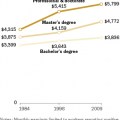 Even as more people spend their lives tethered to the digital world, using smartphone apps and scouring social media feeds, the popularity of mobile banking hasn’t quite caught on in the same manner. This is especially so in regard to some of America’s most affluent residents.
Even as more people spend their lives tethered to the digital world, using smartphone apps and scouring social media feeds, the popularity of mobile banking hasn’t quite caught on in the same manner. This is especially so in regard to some of America’s most affluent residents.
That’s according to a recent study from Nielsen, the media and market research firm. Nielsen’s study focused on the population it calls “mass affluent.” This group lives in households with an estimated $250,000 to $1 million in liquid assets.
The mass affluent are estimated to control about 26% of the country’s total wealth. Nielsen’s research into the acceptance of mobile banking included members of the Millennial and Baby Boomer generations.
Researchers discovered that resistance to mobile banking extends not only to the less tech-savvy older generation, but also to those in the Millennial group, arguably the most tech-friendly of all generations at present time.
Nielsen researchers found that some 27% of mass affluent Millennials check their financial account balances via mobile applications, but only about 18% are willing to transfer funds using this method.
About 21% of this Millennials said they’ve experienced problems using mobile banking applications in the past.
When researchers delved into the Baby Boomer generation they found that about 20% of this group didn’t know how to use mobile banking apps. This, researchers concluded, might explain why only an estimated 5% of mass affluent Boomers use mobile devices to check their balances.
When they do use mobile, Boomers are more likely to use tablets rather than smartphones.
Interestingly, members of both generations were less hesitant to use traditional online banking than mobile applications.
Boomers, Nielsen found, are rather active in online banking with some 92% saying it is their preferred choice for bill paying. More than 65% of mass affluent Millennials say they pay their bills online.
Researchers also delved into the reasons for hesitancy in regard to mobile banking. They found that 67% of Boomers felt they couldn’t trust the method while 71% of Millennials said the same.
The digital age has also given rise to the creation of alternative payment methods, including Amazon Flexible Payments, Bill Me Later, PayPal and Checkout by Amazon.
Nielsen researchers found the most accepted of these options among mass affluent Millennials included Amazon Flexible Payments, Checkout by Amazon and Google Checkout.
Mass affluent Boomers are more likely to use Bill Me Later.
While mobile banking hasn’t caught on as strongly as the more traditional online option, Nielsen concludes the situation leaves the door open for companies that are able to address the desires and hesitancies of consumers.





